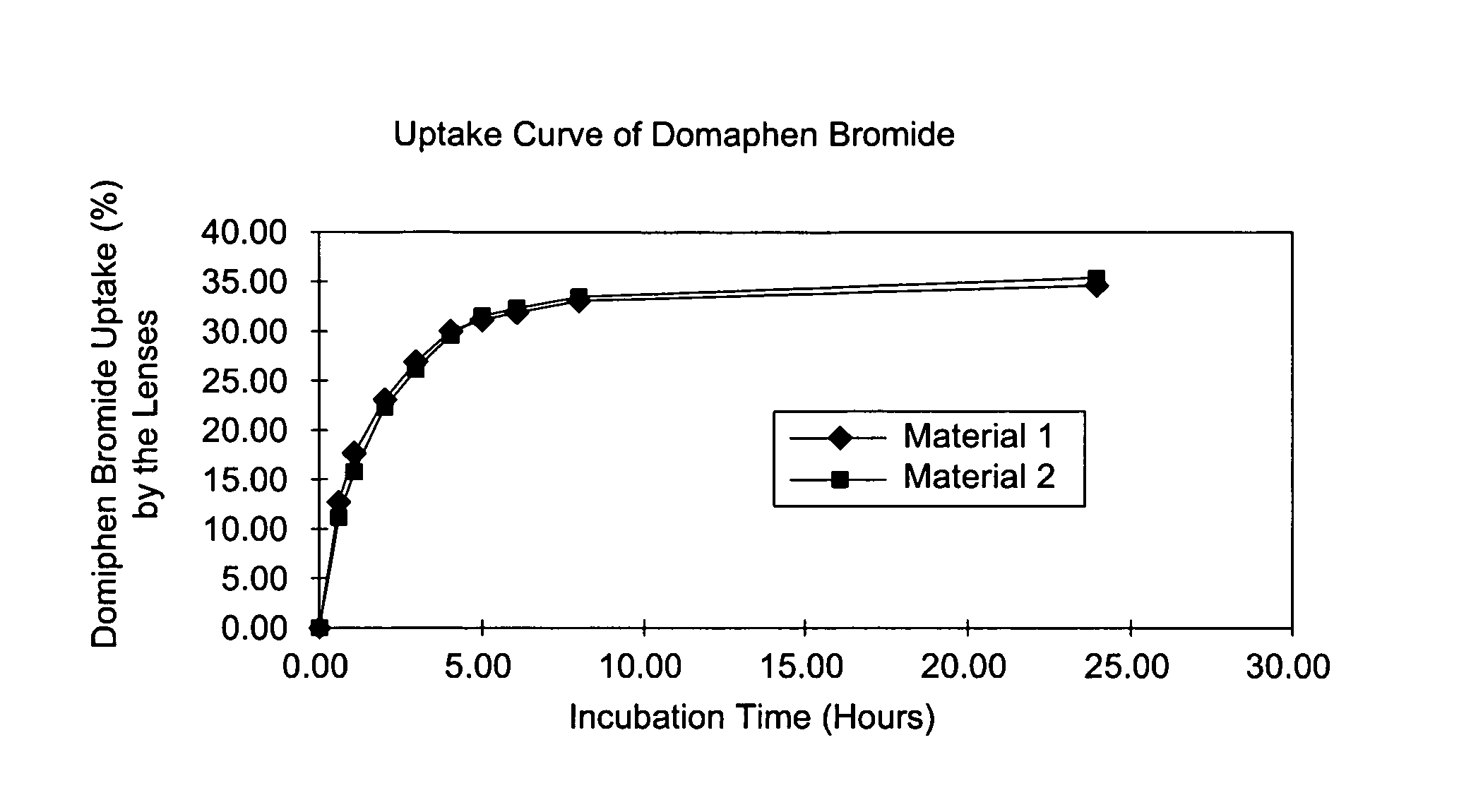Contact lens with improved biocidal activity and related methods and materials
a technology of contact lenses and biocidal activity, applied in the field of contact lenses, can solve the problems that the lens is only able to contact the surface of the lens, and the antimicrobial coating has only a chance of killing the microbes that contact the lens, and achieves the effect of low toxicity
- Summary
- Abstract
- Description
- Claims
- Application Information
AI Technical Summary
Benefits of technology
Problems solved by technology
Method used
Image
Examples
example 1
Test Formulations
[0066] One or more of the following composition was prepared to test the biocidal effect of domiphen bromide.
TABLE 1Composition of Test FormulationsIngredient / Property% W / WSodium Borate0.09Boric Acid0.85Sodium Chloride0.45Domiphen Bromide10 ppm-100 ppmpH = 7.0Osmo.(mOsmo / Kg) = 270
example 2
Biocidal Test Results
[0067] A test was conducted to study the microbiocidal efficacy of solutions prepared according to the present invention with TEA as compared to the same solutions prepared without TEA. Three test solutions were prepared in accordance with the Test Formulation that was identified above as Table 1 with domaphen bromide concentrations of 10 ppm (Solution 1), 30 ppm (Solution 2) and 90 ppm (Solution 3). The antimicrobial efficacy of Solutions 1-3 for the chemical disinfection of contact lenses was evaluated. Microbial challenge inoculums were prepared using Pseudomonas aeruginosa (ATCC 9027), Staphylococcus aureus (ATCC 6538), Serratia marcescens (ATCC 13880), Candida albicans (ATCC 10231) and Fusarium solani (ATCC 36031).
[0068] The test organisms were cultured on appropriate agar and the cultures were harvested using sterile Dulbecco's Phosphate Buffered Saline plus 0.05 percent weight / volume polysorbate 80 (DPBST) or a suitable diluent and transferred to a suit...
example 3
Uptake of Domaphen Bromide in Tris(hydroxymethyl)aminomethane
[0075] Buffer System
[0076] Three solutions made according to the formulation of Example 1 were made with a 25 ppm (Solution 4), 50 ppm (Solution 5) and 100 ppm (Solution 6) domaphen bromide concentrations, except the borate buffer system was replaced with an equivalent amount of a tris(hydroxymethyl)aminomethane buffer system and the water amount was adjusted accordingly. The term “equivalent amount” means the amount required to adjust the pH to the desired pH as another buffer.
[0077] Two 3 ml portions of Solutions 4-6 in solution were placed in six separate vials. A total of six Sureview™ lens (Johnson & Johnson, New Brunswick, N.J.) were placed in the vials—one lens per each vial. The vials remained in the lens for a first 24 hour soaking cycle. After 24 hours, the lenses were removed. The amount of domaphen bromide remaining in each of the 3 ml solutions is measured by ultraviolet visible (UV / VIS) spectrometer analyt...
PUM
 Login to View More
Login to View More Abstract
Description
Claims
Application Information
 Login to View More
Login to View More - R&D
- Intellectual Property
- Life Sciences
- Materials
- Tech Scout
- Unparalleled Data Quality
- Higher Quality Content
- 60% Fewer Hallucinations
Browse by: Latest US Patents, China's latest patents, Technical Efficacy Thesaurus, Application Domain, Technology Topic, Popular Technical Reports.
© 2025 PatSnap. All rights reserved.Legal|Privacy policy|Modern Slavery Act Transparency Statement|Sitemap|About US| Contact US: help@patsnap.com

